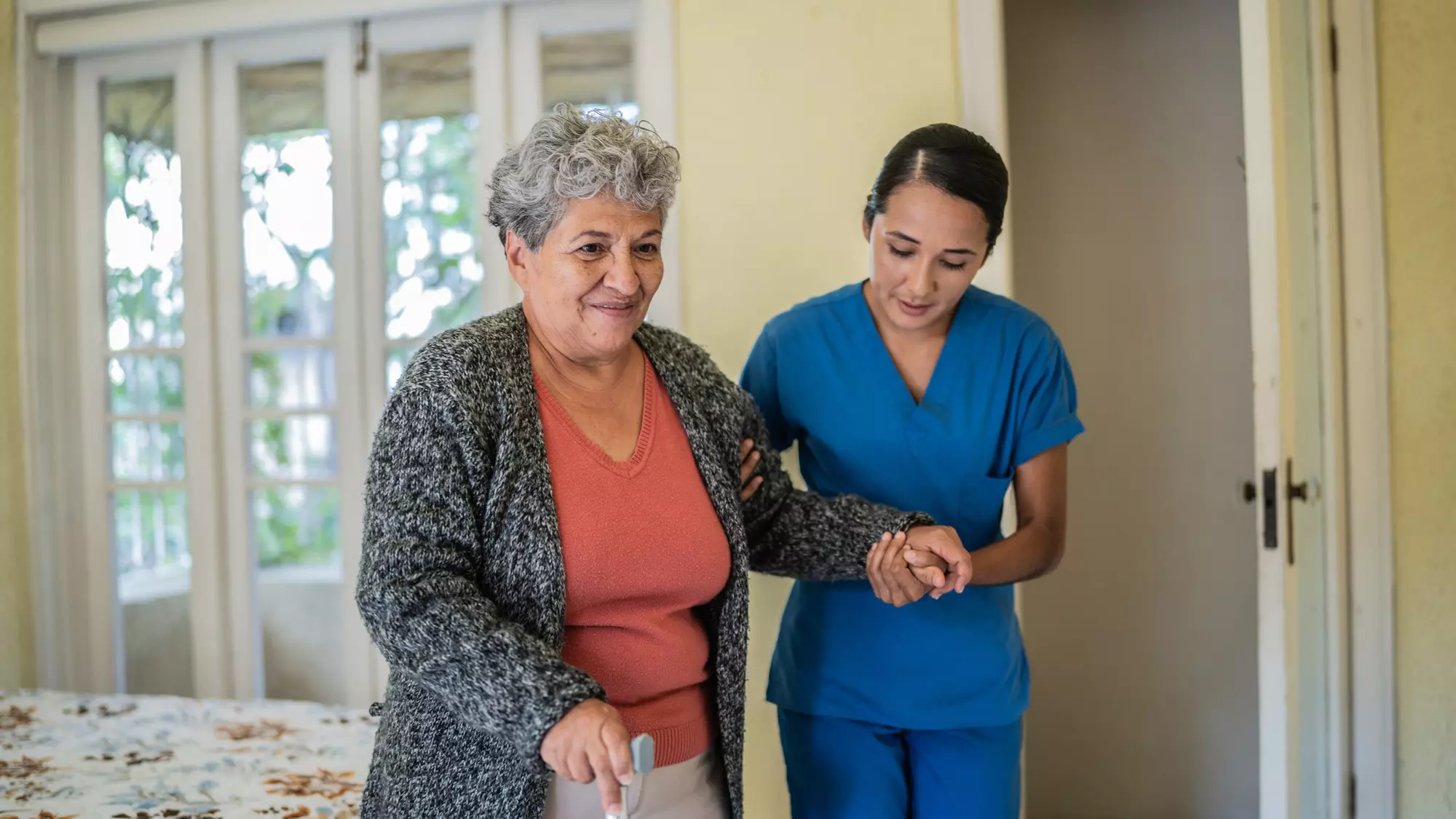As your parents age, it’s only natural to want to be there for them every step of the way. However, day-to-day caregiving duties can sometimes feel overwhelming, even for the most experienced caregivers.
Furthermore, supporting them alone can be emotionally and physically draining as their needs increase, often leaving little time for self-care or other important responsibilities.
Respite care services can provide the support and care your loved one needs while you take the time to rest or attend to other duties. But how many hours of respite care are you allowed? And how long can someone stay in respite care?
In this blog, we’ll answer these questions and more to help guide you through your caregiving journey.
What Is Respite Care?
Respite care services are designed to give caregivers a break while ensuring that your loved one continues to receive the right kind of support for their specific needs. Respite care is especially helpful for adult children or family caregivers supporting aging parents, because it allows them to step away for a short time without worrying about their loved one’s well-being.
The length of stay in respite care can range from just a few hours to several days or even weeks. However, the exact number of respite hours you’re allowed can vary significantly depending on various key factors, including your location, the type of support offered, and your loved one’s circumstances.
Types of Respite Care Options
Respite care services can be offered in a variety of settings, depending on your family member’s unique needs and specific circumstances.
Let’s take a closer look at the types of respite care options available:
- Adult Day Programs: Adult day programs typically offer support and supervision throughout the day, enabling individuals to return home in the evening. These services are usually provided at senior centers or dedicated adult day care centers. Most providers offer meals, snacks, daytime supervision, and activities that your loved one can participate in. Transportation services may also be available for an extra charge. Adult day care services are often the right choice for families who need extra help during the day but don’t require an overnight stay.
- Community-Based Care: Respite services may also be offered as a short-term stay in a senior living community, such as assisted living. This type of respite may be provided for hours, days, or weeks, depending on what’s needed. However, not all communities offer respite services, so it’s always a good idea to check in advance.
- In-Home Care: Families can also hire professional caregivers, either directly or through an agency, to provide respite services at home. In this arrangement, a professional caregiver may visit your loved one to offer necessary assistance, such as companionship, help with activities of daily living (ADLs), or running errands. In-home care is often ideal for individuals who wish to receive the support they need in the familiar comfort of home.
- Skilled Nursing: Skilled nursing respite is typically required for individuals who need access to medical services due to an injury, surgery, or a serious health condition. This type of support often involves trained health care professionals, including registered nurses and doctors, who can manage complex medical needs. Skilled nursing respite services can be provided in a hospital, nursing home, or even at home.
- Respite Care Through Hospice: Hospice services provide compassionate end-of-life support for individuals with terminal illnesses, like cancer, kidney failure, or advanced diabetes. The focus is primarily on symptom and pain management, rather than curative treatments, during a person’s final stages of life. To qualify for hospice care, individuals may need to discontinue curative treatment options, and have a life expectancy of six months or less, as determined by their doctor.

How Many Hours of Respite Care Are Allowed?
When planning for your loved one’s support, you might ask: “How many hours of respite care are you allowed?” or “How long can respite care last?” There are several important factors to consider when determining the number of respite hours you can access, including:
- Source of Funding: The source of funding for respite care plays a significant role in determining how many hours are allowed. In many cases, different funding options come with specific limits. For example:
- Medicare: Medicare provides respite care coverage only through the hospice benefit for terminally ill patients with less than six months to live, allowing for short-term inpatient stays (up to five consecutive days) at a Medicare-certified community to give primary caregivers a necessary break.
- Medicaid: Medicaid offers respite care to eligible individuals through home and community-based services (HCBS) waivers. However, Medicaid respite care hours can vary depending on where you live, as each state sets its own limits based on available resources and individual needs.
- VA Benefits: If your loved one qualifies, VA benefits may cover up to 30 days of respite care. However, placement is usually determined by a VA social worker after evaluating the person’s needs.
- Long-Term Insurance: The number of respite care hours provided by long-term insurance can vary significantly depending on your provider and your specific policy. Some plans may offer a set amount per week, month, or year, while others may not cover respite care at all. To determine your specific allowance, you must contact your private insurance provider directly to review your policy details.
- Non-Profit Grants: Many non-profit organizations, like the National Council on Aging, offer grants to support caregivers by providing respite care services. These grants may cover a specific number of hours or offer funding for a set period, based on the needs of the caregiver and their loved one. However, the number of hours granted can depend on factors such as the organization’s resources and the caregiver’s circumstances. It’s essential to check with the specific non-profit offering the grant to understand how many hours of respite care they can provide and how to qualify.
- Geographical Location: The availability of respite care services and the number of hours allowed can also depend on where you live. Respite care programs often vary widely from one state to another, and even from one county to another. Some regions may have more generous programs or higher funding allocations for respite care, while others may offer fewer hours or more restrictions. Local government programs or community organizations may also have their own rules and funding structures that affect how many hours of respite care are available.
- Your Loved One’s Needs: The exact services that a person needs can impact the number of respite hours required. If your loved one needs specialized medical care or requires round-the-clock supervision, you may need access to more hours of respite care to help manage their needs. For instance, someone with advanced Alzheimer’s disease or mobility challenges might need more frequent support, which could qualify them for additional respite hours.
- Type of Respite Care: The type of respite care you choose also influences how many hours are available. Here’s how it typically works:
- In-Home Care: The number of hours of in-home respite care may be limited by the length of time a caregiver can work or by the availability of trained professionals in your area.
- Out-of-Home Day Care: For programs like adult day care, respite care is often limited by the provider’s operating hours. Most day care programs run for about 8 to 12 hours a day, so the respite care hours would typically reflect this schedule.
- Community-Based Care: Community-based respite care services may allow for extended stays, particularly if the community offers 24-hour support. However, not all communities provide respite services, so it’s important to check in advance.
How Long Can Someone Stay in Respite Care?
When considering respite care for their loved ones, families often wonder: “How long is respite care usually?” The length of stay in respite care can vary based on the specific provider and your loved one’s unique situation.
Generally speaking, respite care arrangements can be either continuous or intermittent, depending on the needs of the person receiving support and what works best for the caregiver.
Let’s take a closer look at the two types:
- Intermittent or In-Home Care: In this arrangement, families hire caregivers to provide extra support at the loved one’s home. A professional caregiver comes in for a few hours at a time, typically for a set number of days each week, to assist with unique needs. The duration of intermittent care can vary, but it usually lasts a few hours to a full day.
- Continuous or Inpatient Care: Continuous care, on the other hand, typically involves an overnight stay, usually at a residential setting like a senior living community, nursing home, or hospice center. In this setup, the caregiver is typically given a longer break, ranging from a few days to several weeks, depending on the needs of the caregiver and the availability of support services.
How Do You Pay for Respite Care?
On average, respite care costs range from $100 to $300 per day, with prices typically increasing for more specialized care, like skilled nursing or hospice-related respite. However, this cost may vary depending on factors like the specific provider, your location, and the level of support your loved one requires.
Here are some common methods families typically use to cover respite care costs:
- Medicare: Medicare typically covers up to five days of inpatient respite care in a Medicare-certified provider, like a nursing home or hospice care center, as part of your loved one’s hospice benefits. After this, you may need to pay out-of-pocket or seek other financial assistance options.
- Long-Term Insurance: Caregivers often ask, “Does insurance pay for respite care?” Most private insurance plans do not typically cover respite care costs. However, some long-term care insurance policies may have specific provisions for respite that can help pay a portion of the costs. Keep in mind that coverage varies widely, so you’ll need to check your specific policy for details.
- Non-Profits and Community Grants: Non-profit organizations and community grants, including those offered by the ARCH Network, may provide funding or subsidies to help cover respite care costs. These grants can cover a few days to a few weeks of care, but they often have eligibility requirements and may still leave some costs for you to cover.
| Provider | Coverage | Shortest Time Covered | Longest Time Covered | Difference You May Need to Pay |
|---|---|---|---|---|
| Medicare | Covers up to 5 days of inpatient respite care in a certified community per benefit period | 1 day | 5 days | After 5 days, you will have to cover costs out of pocket or through other means. |
| Long-Term Insurance | Varies by policy; some long-term insurance plans cover respite care services as part of their long-term care benefits. | A few hours | A few days | Typically, you’ll need to pay the difference if the insurance doesn’t cover the full cost. |
| Non-Profits and Community Grants | Some non-profits offer grants or subsidies to cover respite care. | Varies by grant | Varies by grant | If the grant doesn’t cover the entire service, you may be required to contribute a portion of the cost. |
| Out-of-pocket (Private Pay) | Full cost coverage if you pay directly for services. | A few hours | Weeks or more | You pay the full amount unless other funding sources are available. |

How to Find Out Your Exact Respite Care Limit
Understanding your exact respite care limit is key to planning for your loved one’s care needs and knowing what costs you might need to cover. To make sure you’re clear on how many hours of respite care you’re entitled to, there are a few steps you can take. Here’s how you can confirm your specific coverage and available hours:
- Call Your Insurance Provider: If your family member has a long-term insurance policy, reach out to their insurance company and ask them to provide you with a clear breakdown of what’s covered under the plan, including:
- How many hours of respite care are included
- What type of support is covered
- Any restrictions or limits on the number of days or hours you can use per year
- Contact Medicare or Medicaid: For those using Medicare or Medicaid, each program has its own rules about how much respite care it will cover. To find out the specifics, contact the Medicare hotline (1-800-MEDICARE) or your local Medicaid office. Be sure to ask:
- How many days or hours of respite care are covered per year
- Do I meet specific conditions (such as hospice eligibility) to access respite care
- Any co-pays or additional out-of-pocket costs you may need to pay
- Reach Out to Communities: Some providers may have waitlists or specific requirements for accessing respite services, so it’s a good idea to get all the details up front. Consider reaching out directly to the communities that offer respite care by calling their office or visiting their website to ask:
- What respite care options they provide
- The maximum number of hours they offer
- Any eligibility criteria or application process you need to follow
- Ask About Extra Hours if Needed: If you find that the coverage provided isn’t enough for your needs, don’t hesitate to ask about additional options:
- Can you purchase extra hours of care if needed?
- Are there other programs or grants available to help cover the cost of extra hours?
- Are there flexible payment plans or sliding scales based on your financial situation?
StoryPoint Group Communities: Here for You and Your Loved One
At StoryPoint Group communities, we recognize the challenges families face in finding the best support for their loved ones. Please know you are not alone. We are here to help guide you and your parent every step of the way.
If someone you care for could benefit from additional support services, we’d love to be part of their journey.
To learn more about our communities or speak with one of our friendly Community Experts, contact us or schedule a tour at your nearby StoryPoint Group community.











